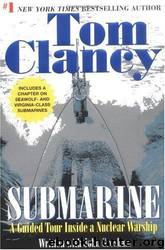Submarine: A Guided Tour Inside a Nuclear Warship by Tom Clancy; John Gresham

Author:Tom Clancy; John Gresham
Language: eng
Format: mobi
Tags: Technology & Engineering, Transportation, Naval, Nuclear submarines, General, Ships & Shipbuilding, Military, Military Science, History
ISBN: 9780425190012
Publisher: Berkley Books
Published: 2003-05-06T04:17:22+00:00
Another problem for potential hunters of Russian SSBNs results from the manner in which they are employed and deployed. One of the early goals of missile designers in the former Soviet Union was to make the ranges of their sub-launched missiles as long as possible. It is an acknowledged fact that CIS boomers can launch their missiles at targets in the continental United States from alongside piers at their Kola Peninsula bases. Consequently the only reason the Russian leadership has for moving them is to hide them against possible attack by aircraft or missiles. And like prized jewels, the CIS Navy tends to place them in the maritime equivalent of bank vaults: the “boomer bastions.”
Bastions were originally created to place Soviet SSBNs beyond the reach of Western ASW forces. While the actual location and layout of a boomer bastion is a highly sensitive subject in both the Pentagon and the Kremlin, the basic concept is quite simple: an SSBN is placed in a patrol area that is highly defendable and as remote from Western operating areas as possible. The Barents Sea, the Kara Gulf, the Sea of Okhotsk, and even sites under the polar ice pack have been suggested as possible bastion areas. This may mean the SSBN is placed in an area with entrances that are easily defended, or it might be surrounded by a belt of ASW mines. In addition, it probably is aggressively defended by Russian attack submarines, maritime patrol aircraft, and, if available, surface ASW groups.
Clearly, a boomer bastion is not the kind of target a carrier battle group is going to take on. In fact, a modern SSN is the only platform that can even begin to think about penetrating the bastions and pursuing the Russian SSBNs contained therein. Back in the early 1980s the U.S. maritime strategy had NATO trying to actively pursue the Soviet boomers in their lairs. Today the task is made more difficult by the decreased size of the NATO SSN force and the greater stealth of the CIS SSBNs.
Let’s assume that Western intelligence services manage to find a boomer bastion. The method is not particularly important—it might be a satellite photo of a missile boat breaking through the polar ice during a missile drill, or radio traffic from a supporting surface group. For our purposes, though, we will assume that the target is a Typhoon-class SSBN being protected by an Akula-class SSN. Their bastion area is a parcel of the Barents Sea that overlaps the polar ice pack in what is called the marginal ice zone. The interface between the polar pack and the marginal ice zone is an extremely complex acoustic environment. All the noise from the ice floes breaking apart and grinding together makes it very difficult to locate and track an opposing submarine. In addition the boomer, much like a rat in a warehouse, has a back door to run to under the ice. For this reason, only the most capable of American submarines, an Improved Los Angeles (688I), is suitable.
Download
This site does not store any files on its server. We only index and link to content provided by other sites. Please contact the content providers to delete copyright contents if any and email us, we'll remove relevant links or contents immediately.
Small Unmanned Fixed-wing Aircraft Design by Andrew J. Keane Andras Sobester James P. Scanlan & András Sóbester & James P. Scanlan(32149)
Navigation and Map Reading by K Andrew(4560)
Endurance: Shackleton's Incredible Voyage by Alfred Lansing(3856)
Wild Ride by Adam Lashinsky(1661)
And the Band Played On by Randy Shilts(1623)
The Box by Marc Levinson(1602)
Top 10 Prague (EYEWITNESS TOP 10 TRAVEL GUIDES) by DK(1572)
The Race for Hitler's X-Planes: Britain's 1945 Mission to Capture Secret Luftwaffe Technology by John Christopher(1531)
The One Percenter Encyclopedia by Bill Hayes(1470)
Girls Auto Clinic Glove Box Guide by Patrice Banks(1369)
Trans-Siberian Railway by Lonely Planet(1350)
Looking for a Ship by John McPhee(1324)
Batavia's Graveyard by Mike Dash(1306)
Fighting Hitler's Jets: The Extraordinary Story of the American Airmen Who Beat the Luftwaffe and Defeated Nazi Germany by Robert F. Dorr(1305)
Troubleshooting and Repair of Diesel Engines by Paul Dempsey(1289)
Bligh by Rob Mundle(1279)
TWA 800 by Jack Cashill(1257)
The Great Halifax Explosion by John U. Bacon(1233)
Ticket to Ride by Tom Chesshyre(1233)
